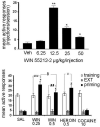Self-administration of cannabinoids by experimental animals and human marijuana smokers
- PMID: 15932767
- PMCID: PMC2679508
- DOI: 10.1016/j.pbb.2005.01.026
Self-administration of cannabinoids by experimental animals and human marijuana smokers
Abstract
Drug self-administration behavior has been one of the most direct and productive approaches for studying the reinforcing effects of psychoactive drugs, which are critical in determining their abuse potential. Cannabinoids, which are usually abused by humans in the form of marijuana, have become the most frequently abused illicit class of drugs in the United States. The early elucidation of the structure and stereochemistry of delta-9-tetrahydrocannabinol (THC) in 1964, which is now recognized as the principal psychoactive ingredient in marijuana, activated cannabinoid research worldwide. This review examines advances in research on cannabinoid self-administration behavior by humans and laboratory animals. There have been numerous laboratory demonstrations of the reinforcing effects of cannabinoids in human subjects, but reliable self-administration of cannabinoids by laboratory animals has only recently been demonstrated. It has now been shown that strong and persistent self-administration behavior can be maintained in experimentally and drug-naïve squirrel monkeys by doses of THC comparable to those in marijuana smoke inhaled by humans. Furthermore, reinforcing effects of some synthetic CB1 cannabinoid agonists have been recently reported using intravenous and intracerebroventricular self-administration procedures in rats and mice. These findings support previous conclusions that THC has a pronounced abuse liability comparable to other drugs of abuse under certain experimental conditions. Self-administration of THC by squirrel monkeys provides the most reliable animal model for human marijuana abuse available to date. This animal model now makes it possible to study the relative abuse liability of other natural and synthetic cannabinoids and to preclinically assess new therapeutic strategies for the treatment or prevention of marijuana abuse in humans.
Figures





Similar articles
-
Self-administration behavior is maintained by the psychoactive ingredient of marijuana in squirrel monkeys.Nat Neurosci. 2000 Nov;3(11):1073-4. doi: 10.1038/80577. Nat Neurosci. 2000. PMID: 11036260
-
Cannabinoids: reward, dependence, and underlying neurochemical mechanisms--a review of recent preclinical data.Psychopharmacology (Berl). 2003 Sep;169(2):115-34. doi: 10.1007/s00213-003-1485-z. Epub 2003 Jun 24. Psychopharmacology (Berl). 2003. PMID: 12827346 Review.
-
The opioid antagonist naltrexone reduces the reinforcing effects of Delta 9 tetrahydrocannabinol (THC) in squirrel monkeys.Psychopharmacology (Berl). 2004 Apr;173(1-2):186-94. doi: 10.1007/s00213-003-1693-6. Epub 2003 Dec 11. Psychopharmacology (Berl). 2004. PMID: 14668977
-
Self-administration of delta9-tetrahydrocannabinol (THC) by drug naive squirrel monkeys.Psychopharmacology (Berl). 2003 Sep;169(2):135-40. doi: 10.1007/s00213-003-1484-0. Epub 2003 Jun 24. Psychopharmacology (Berl). 2003. PMID: 12827345
-
Preclinical studies on the reinforcing effects of cannabinoids. A tribute to the scientific research of Dr. Steve Goldberg.Psychopharmacology (Berl). 2016 May;233(10):1845-66. doi: 10.1007/s00213-016-4244-7. Epub 2016 Mar 30. Psychopharmacology (Berl). 2016. PMID: 27026633 Free PMC article. Review.
Cited by
-
Repeated Δ9-tetrahydrocannabinol exposure in adolescent monkeys: persistent effects selective for spatial working memory.Am J Psychiatry. 2014 Apr;171(4):416-25. doi: 10.1176/appi.ajp.2013.13030335. Am J Psychiatry. 2014. PMID: 24577206 Free PMC article.
-
Smoke and Mirrors: The Recreational Marijuana Debate.Linacre Q. 2020 Aug;87(3):254-258. doi: 10.1177/0024363920916284. Epub 2020 Apr 13. Linacre Q. 2020. PMID: 32699434 Free PMC article.
-
Cannabis Extract Composition Determines Reinforcement in a Vapor Self-Administration Paradigm.J Neurosci. 2020 Aug 12;40(33):6264-6266. doi: 10.1523/JNEUROSCI.0814-20.2020. J Neurosci. 2020. PMID: 32801126 Free PMC article. No abstract available.
-
Assessment of Acute Motor Effects and Tolerance Following Self-Administration of Alcohol and Edible ∆9 -Tetrahydrocannabinol in Adolescent Male Mice.Alcohol Clin Exp Res. 2019 Nov;43(11):2446-2457. doi: 10.1111/acer.14197. Epub 2019 Sep 29. Alcohol Clin Exp Res. 2019. PMID: 31524960 Free PMC article.
-
Blockade of THC-seeking behavior and relapse in monkeys by the cannabinoid CB(1)-receptor antagonist rimonabant.Neuropsychopharmacology. 2008 Nov;33(12):2870-7. doi: 10.1038/npp.2008.21. Epub 2008 Feb 27. Neuropsychopharmacology. 2008. PMID: 18305459 Free PMC article.
References
-
- Agurell S, Halldin M, Lindgren JE, Ohlsson A, Widman M, Gillespie H, Hollister L. Pharmacokinetics and metabolism of delta 1-tetrahydrocannabinol and other cannabinoids with emphasis on man. Pharmacol Rev. 1986;38:21–43. - PubMed
-
- Alici T, Appel JB. Increasing the selectivity of the discriminative stimulus effects of D9-tetrahydrocannabinol: complete substitution with methanandamide. Pharmacol Biochem Behav. 2004 In press: manuscript PBB-69517. - PubMed
-
- Arnold JC, Hunt GE, McGregor IS. Effects of the cannabinoid receptor agonist CP 55,940 and the cannabinoid receptor antagonist SR 141716 on intracranial self-stimulation in Lewis rats. Life Sci. 2001;70:97–108. - PubMed
-
- Arnold JM, Roberts DC. A critique of fixed and progressive ratio schedules used to examine the neural substrates of drug reinforcement. Pharmacol Biochem Behav. 1997;57:441–447. - PubMed
Publication types
MeSH terms
Substances
Grants and funding
LinkOut - more resources
Full Text Sources

